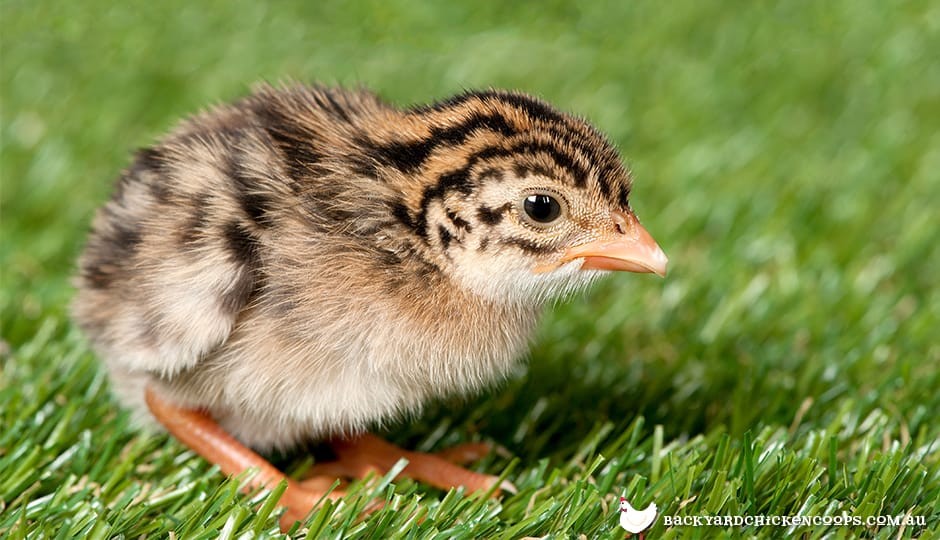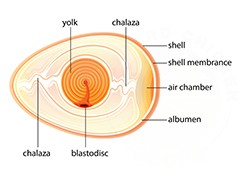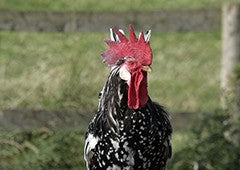It goes without question that Guinea fowl are one of the most unusual, quirky and wacky birds around and their babies are no different. Guinea fowl babies, also known as keets, are rambunctious, excitable and- if we’re being honest- some of the doughiest creatures around. Caring for young Guinea fowl keets is one of the most rewarding experiences you can have with an animal. So long as you have a sense of humour, a little patience and are well informed, raising Guinea fowl keets will be a breeze.
 What to expect from Guinea fowl keets?
What to expect from Guinea fowl keets?
Guinea fowl keets are cute, chirpy, curious and clumsy things that you’ll definitely need to keep an eye on, but the good news is they are so much fun to watch. They scurry about the brooder dazed, confused and excited seemingly without any sense of what they are or where they’re going. This leaves them unfortunately prone to accident, such as dislocated legs, which often results in death if it occurs at an early age.
What do I need to know about brooders?
What is a brooder?
A brooder is essentially a safe, temperature controlled space- normally an extra-large plastic container- that your Guinea fowl keets will be able to spend the first two to six weeks of their life. Some people however renovate their chicken tractors, like the Taj Mahal, into temporary brooders, by positioning the tractor on top of a tarp indoors and inserting heat lamps inside the tractor.
What bedding is best?
Coat the floor of your brooder with newspaper or non-toxic hemp bedding. Avoid other beddings, such as sawdust, otherwise you’re Guinea fowl keets will mistake it for feed and end up with some very upset tummies.
How to keep your Guinea fowl keets warm?
The brooder needs to be kept at approximate 35 degrees Celsius, otherwise your Guinea fowl keets might get a bit cold. A carefully positioned heat lamp with a thermometer strategically placed at the bottom of the brooder is the simplest way to ensure your keets stay warm during this early period of their life. If you’re Guinea fowl keets are huddled together with their eyes closed or squinted, this is a sure sign that they are feeling cold and you will need to warm the brooder up.
How do I clean the brooder?
One of the fabulous things about Guinea fowl keets is the fact that their droppings are an easy to clean dry and powdery substance. The easiest way to clean the brooder is to relocate the baby keets to a safe place, remove the bedding, wipe down the interior of the brooder with a natural cleaner and reline the inside with fresh bedding. Extra points if you use the droppings as fertiliser for your compost.
When can they leave the brooder?
Guinea fowl keets grow especially quickly over the first two weeks and it might be tempting to let them out of the brooder sooner than it is recommended. Generally speaking Guinea fowl keets should remain inside the brooder for the first six weeks of their lives, but feel free to give them excursions to your living room, bathroom or backyard. So long as you monitor the keets as they begin to explore the world, they should remain safe from any of the dangers ahead of them.

What do the baby Guinea fowl keets eat and drink?
What do they eat?
Adult Guinea fowl are one of the most self-reliant poultry birds around. They are able to graze in your garden all day, eating entire armies of bugs and insect, whilst scavenging all other kinds of treats and goodies. As most Guinea fowl keets won’t be safe to graze in the wild it’s important that you give them plenty of feed while they’re inside the brooder. Simply scatter the feed atop of the newspaper and they will delightedly peck and feed for hours.
What do they drink?
Of course Guinea fowl keets need to drink water. The important thing to note about this is the fact that you will need to secure a drown-proof waterer, otherwise you might wake up one morning to find a nasty surprise inside your brooder.
What to expect if something bad happens to my Guinea fowl keets?
One of the sadder realities about Guinea fowl keets is that if they’re exposed to some kind of trauma during the first few weeks, the more anti-social and fiercely independent they will become. For example, if the other keets tease, bully or attack one particular baby Guinea fowl, it is likely that they will become less socialised as an adult. An anti-social Guinea fowl will be more inclined to chase, tease or act aggressively towards other animals and even humans.
How are Guinea fowl keets raised in the wild?

Guinea fowl have many charms but they are definitely not known for being good parents. Guinea fowl mothers tend to isolate their nest in the wild and savagely protect it from other birds, animals and even humans. Whilst caring for the eggs Guinea fowl are dedicated and caring parents committed to the cause of their children. However, once the Guinea fowl keets have hatched the mothers tend to lose interest, wander off and quite generally neglect their young baby keets. The unfortunate truth is that often in the wild a mother might hatch upward of twenty keets however perhaps as few as five will make it to adulthood. Some owners take young Guinea fowl keets under their wings when they are a few days old, once the mother has abandoned them. However be cautious before swoop in and take the baby keets, as the mother may get offended and try to keep them for herself.
Where can I get Guinea fowl keets from?
Most Guinea fowl breeders will also sell the keets, from as little as one day old. It’s in your best interest to get as young a Guinea fowl keet as possible, as they have trouble adjusting the new environment as they get older, which you can read about here. It’s probably best to call the breeder and arrange a suitable time to come and collect the keets, as they are likely to know when the next batch of Guinea will hatch. Sites like Chicken Sales can put you in contact with breeders of Guinea fowl or chickens in your area.
Raising Guinea fowl keets is a delightful, grin-inducing experience that will help you appreciate the little things in life. So long as you are understand the basics and are prepared for the touch of silliness the Guinea fowl will bring to your life, it’s bound to be a rewarding experience.
Once your Guinea fowl have come of age it’s important that they have a safe and sturdy coop to rest in at the end of a fun day eating bugs, like the Taj Mahal, Penthouse and Mansion. Be sure you find out more about how you can keep Guinea fowl with chickens, especially if you’re planning on getting a big and comfortable coop.
If you'd like to know about raising Guinea fowl with chickens just click on the link here.

















